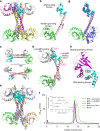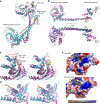BrlR from Pseudomonas aeruginosa is a receptor for both cyclic di-GMP and pyocyanin
- PMID: 29967320
- PMCID: PMC6028453
- DOI: 10.1038/s41467-018-05004-y
BrlR from Pseudomonas aeruginosa is a receptor for both cyclic di-GMP and pyocyanin
Abstract
The virulence factor pyocyanin and the intracellular second messenger cyclic diguanylate monophosphate (c-di-GMP) play key roles in regulating biofilm formation and multi-drug efflux pump expression in Pseudomonas aeruginosa. However, the crosstalk between these two signaling pathways remains unclear. Here we show that BrlR (PA4878), previously identified as a c-di-GMP responsive transcriptional regulator, acts also as a receptor for pyocyanin. Crystal structures of free BrlR and c-di-GMP-bound BrlR reveal that the DNA-binding domain of BrlR contains two separate c-di-GMP binding sites, both of which are involved in promoting brlR expression. In addition, we identify a pyocyanin-binding site on the C-terminal multidrug-binding domain based on the structure of the BrlR-C domain in complex with a pyocyanin analog. Biochemical analysis indicates that pyocyanin enhances BrlR-DNA binding and brlR expression in a concentration-dependent manner.
Conflict of interest statement
The authors declare no competing interests.
Figures







Similar articles
-
The structure of BrlR reveals a potential pyocyanin binding site.FEBS Lett. 2018 Jan;592(2):256-262. doi: 10.1002/1873-3468.12950. Epub 2018 Jan 3. FEBS Lett. 2018. PMID: 29251765
-
Crystal structure of BrlR with c-di-GMP.Biochem Biophys Res Commun. 2017 Aug 19;490(2):260-264. doi: 10.1016/j.bbrc.2017.06.033. Epub 2017 Jun 12. Biochem Biophys Res Commun. 2017. PMID: 28619510
-
BrlR from Pseudomonas aeruginosa is a c-di-GMP-responsive transcription factor.Mol Microbiol. 2014 May;92(3):471-87. doi: 10.1111/mmi.12562. Epub 2014 Mar 6. Mol Microbiol. 2014. PMID: 24612375 Free PMC article.
-
c-di-GMP and its Effects on Biofilm Formation and Dispersion: a Pseudomonas Aeruginosa Review.Microbiol Spectr. 2015 Apr;3(2):MB-0003-2014. doi: 10.1128/microbiolspec.MB-0003-2014. Microbiol Spectr. 2015. PMID: 26104694 Free PMC article. Review.
-
Harnessing Cyclic di-GMP Signaling: A Strategic Approach to Combat Bacterial Biofilm-Associated Chronic Infections.Curr Microbiol. 2025 Feb 5;82(3):118. doi: 10.1007/s00284-025-04091-7. Curr Microbiol. 2025. PMID: 39909925 Review.
Cited by
-
Multidrug-resistant Pseudomonas aeruginosa in immunocompromised cancer patients: epidemiology, antimicrobial resistance, and virulence factors.BMC Infect Dis. 2025 Jun 11;25(1):804. doi: 10.1186/s12879-025-11182-0. BMC Infect Dis. 2025. PMID: 40500701 Free PMC article.
-
The role of bacterial signaling networks in antibiotics response and resistance regulation.Mar Life Sci Technol. 2022 Mar 28;4(2):163-178. doi: 10.1007/s42995-022-00126-1. eCollection 2022 May. Mar Life Sci Technol. 2022. PMID: 37073223 Free PMC article. Review.
-
The Vibrio cholerae master regulator for the activation of biofilm biogenesis genes, VpsR, senses both cyclic di-GMP and phosphate.Nucleic Acids Res. 2022 May 6;50(8):4484-4499. doi: 10.1093/nar/gkac253. Nucleic Acids Res. 2022. PMID: 35438787 Free PMC article.
-
Oligoribonuclease mediates high adaptability of P. aeruginosa through metabolic conversion.BMC Microbiol. 2024 Jan 19;24(1):25. doi: 10.1186/s12866-023-03175-3. BMC Microbiol. 2024. PMID: 38238663 Free PMC article.
-
Bacterial MerR family transcription regulators: activationby distortion.Acta Biochim Biophys Sin (Shanghai). 2022 Jan 25;54(1):25-36. doi: 10.3724/abbs.2021003. Acta Biochim Biophys Sin (Shanghai). 2022. PMID: 35130613 Free PMC article. Review.
References
Publication types
MeSH terms
Substances
Grants and funding
LinkOut - more resources
Full Text Sources
Other Literature Sources

